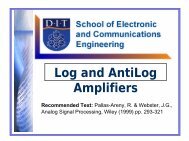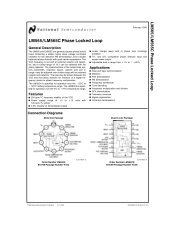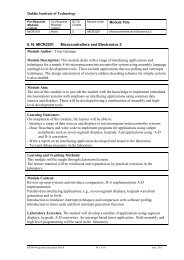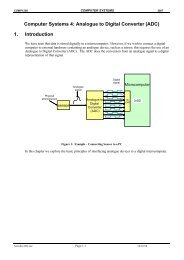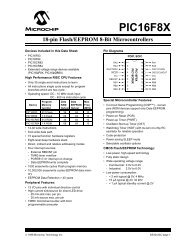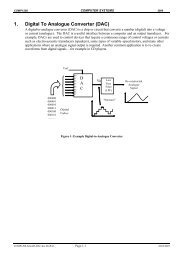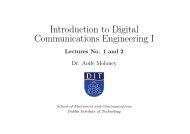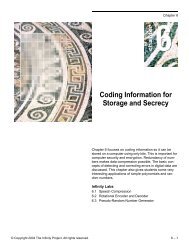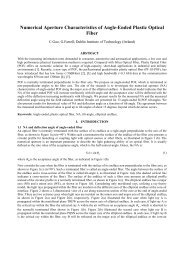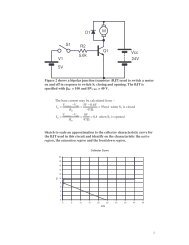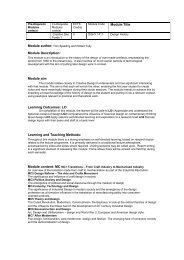simulation of a superheterodyne receiver using pspice - School of ...
simulation of a superheterodyne receiver using pspice - School of ...
simulation of a superheterodyne receiver using pspice - School of ...
Create successful ePaper yourself
Turn your PDF publications into a flip-book with our unique Google optimized e-Paper software.
SIMULATION OF A SUPERHETERODYNE RECEIVER<br />
USING PSPICE<br />
BY COLM GILES<br />
DT008/3<br />
PROJECT PARTNER: GAVIN BYRNE<br />
SUPERVISOR: MR. PAUL TOBIN<br />
ACKNOWLEGEMENT:<br />
I would just like to take this opportunity to thank my project partner Gavin Byrne, and<br />
a special thank you and word <strong>of</strong> appreciation to my supervisor for this project, Mr.<br />
Paul Tobin. I am very grateful for his help and guidance throughout the three month<br />
duration <strong>of</strong> the project.<br />
1
PAGE INDEX:<br />
TITLE<br />
PAGES<br />
DIT cover page. 1<br />
Title page. 2<br />
Page Index. 3<br />
Chapter 1: Project Organisation. 4<br />
Chapter 2: Introduction. 5-7<br />
Chapter 3:<br />
Technical description and construction details<br />
(including test procedures and results).<br />
Part 1: Generation <strong>of</strong> an AM wave. 8-11<br />
Part 2: Design <strong>of</strong> a single tuned RF amplifier. 12-15<br />
Part 3: Local Oscillator design. 16-24<br />
Part 4: Design <strong>of</strong> mixer circuit. 25-27<br />
Part 5: Design <strong>of</strong> IF stage. 28-31<br />
Part 6: AM detection with AGC. 32-35<br />
Part 7: Design <strong>of</strong> pre-amplifier and power amplifier. 36-39<br />
Chapter 4:<br />
Final tests and results<br />
(hierarchy structure). 40-51<br />
Chapter 5: Conclusions 52-55<br />
Appendix A: S<strong>of</strong>tware used. 56<br />
Appendix B: References. 57<br />
Appendix C: Scale suffixes. 58<br />
Appendix D: Schematics and probes. 59<br />
Acknowledgement. 60<br />
2
CHAPTER 1: PROJECT ORGANISATION.<br />
The purpose <strong>of</strong> this project was to simulate a complete superhetrodyne <strong>receiver</strong> <strong>using</strong><br />
Pspice. Initially the project was broken into eight separate blocks to be designed and<br />
tested separately and then to be implemented together <strong>using</strong> hierarchical methods. The<br />
blocks were divided as follows; I concentrated on the RF amplifier, the IF amplifiers<br />
and the audio amplifier and Gavin took charge <strong>of</strong> the AM wave generation, the mixer<br />
and the AM detection with AGC. The local oscillator circuit provided most problems<br />
and was mainly dealt with simultaneously. However it must be noted that strict<br />
adherence to these divisions was not followed as problems arose with circuits and<br />
<strong>of</strong>ten problem solving was dealt with by consultation. Another reason for this was that<br />
a better understanding <strong>of</strong> the complete circuit was obtained from working on all<br />
sections <strong>of</strong> the project.<br />
CHAPTER 2: INTRODUCTION.<br />
3
Aims, objectives and specifications: The aim <strong>of</strong> this project is to simulate a complete<br />
superhetrodyne <strong>receiver</strong> <strong>using</strong> Pspice. The specifications set out at the beginning <strong>of</strong><br />
the project were to take the basic block diagram for the superhetrodyne <strong>receiver</strong>,<br />
shown below in Fig.1, design and simulate each section separately <strong>using</strong> the<br />
MicroSim Pspice program Version8. With this completed use the Pspice Top-down<br />
approach with hierarchical design methods to simulate the entire superhetrodyne<br />
<strong>receiver</strong>.<br />
Fig. 1:The block diagram <strong>of</strong> the Superheterodyne <strong>receiver</strong>. Ref [8] Appendix B<br />
Materials and information provided by the supervisor at the start <strong>of</strong> the project<br />
included Ref. [1] “Communication Engineering Theory Notes” and Ref. [2] “Pspice<br />
Lab Manual” by Paul Tobin for third year degree in Applied Electronics (SEE3).<br />
Reference texts advised: Ref. [3] “Electronic Communication Techniques, Fourth<br />
Edition” by Paul Young (Publ. Prentice Hall), Ref. [4] “Pspice for Windows, A<br />
Circuit Simulation Primer” by Roy W. Goody (Publ. Prentice Hall), Ref. [5] “Pspice<br />
for Windows, Volume 2, Operational Amplifiers & Digital Circuits” by Roy W.<br />
Goody (Publ. Prentice Hall). See Appendix B<br />
Background theory: The basic requirement for any communications <strong>receiver</strong> is to<br />
have the ability to select a signal <strong>of</strong> desired frequency, while rejecting closely<br />
adjacent frequencies (Selectivity) and provide sufficient amplification to recover the<br />
4
modulating signal (Sensitivity). A <strong>receiver</strong> with good selectivity will isolate the<br />
desired signal in the RF spectrum and eliminate all other signals. This can be achieved<br />
<strong>using</strong> tuned LC circuits resonating at the desired frequency. LC circuits with a high Q<br />
value have narrower bandwidths and hence have better selectivity. However it must<br />
be noted the bandwidth must be sufficiently large such that it passes the carrier as<br />
well as the sidebands to avoid attenuation and hence distortion <strong>of</strong> the transmitted<br />
information. The sensitivity <strong>of</strong> a communications <strong>receiver</strong> is a function <strong>of</strong> the overall<br />
<strong>receiver</strong> gain. In general, higher gain means better the sensitivity. This can be<br />
achieved by multiple stages <strong>of</strong> amplification.<br />
There are two types <strong>of</strong> communications <strong>receiver</strong>; the Tuned Radio Frequency (TRF)<br />
<strong>receiver</strong> and the Superheterodyne <strong>receiver</strong>. Although the TRF system is a<br />
straightforward concept at high frequencies it becomes difficult to build, is less<br />
efficient, has small gain and suffers bandwidth changes. For these reasons among<br />
others the Superheterodyne <strong>receiver</strong> has become the model for all <strong>receiver</strong>s; AM, FM,<br />
television, satellite, radar etc. It was developed during WW1 by Edwin Armstrong but<br />
did not become popular until the 1930s.<br />
Following the block diagram Fig. 1 above, the incoming signal is picked up on the<br />
antenna and fed to an RF amplifier. The RF amplifier provides some initial gain and<br />
selectivity and minimises radiation <strong>of</strong> the Local Oscillator (LO) signal through the<br />
receiving antenna by isolating the Mixer from the antenna. However, the most<br />
important function <strong>of</strong> the RF amplifier is to eliminate what is known as the image<br />
signal. The frequency <strong>of</strong> this signal is greater than the LO and will mix to give a<br />
mixer output at the IF frequency. This will cause problems as after down conversion<br />
to IF it will appear at the same frequency as the desired signal and cause interference.<br />
Therefore, signals at the image frequency must be eliminated before the mixer stage.<br />
The value <strong>of</strong> the image frequency is:<br />
f = f + 2 f<br />
image<br />
RF<br />
IF<br />
5
The output <strong>of</strong> the RF amplifier is then applied to the input <strong>of</strong> the Mixer. It also has an<br />
input from the LO. The Mixer (or Frequency Converter) is a non-linear device, which<br />
results in the creation <strong>of</strong> sum and difference frequencies. The output from the Mixer is<br />
a combination <strong>of</strong> the received signal and the LO signal as well as their sum and<br />
difference frequencies. This process is called Heterodyning. The non-linearity is<br />
necessary to provide the mathematical equivalent <strong>of</strong> time multiplication between the<br />
LO voltage and the RF signal voltage. A tuned circuit at the Mixer output selects the<br />
Difference frequency (i.e. the IF or Intermediate frequency). The LO frequency is<br />
tuneable over a wide range and therefore the Mixer can translate a wide range <strong>of</strong> input<br />
frequencies to the IF. The LO frequency is higher than incoming RF frequency (High<br />
Side Injection) for engineering reasons.<br />
f = f +<br />
LO<br />
RF<br />
f<br />
IF<br />
Therefore the difference or intermediate frequency (IF) is<br />
f<br />
IF<br />
= f − f . This<br />
LO<br />
RF<br />
frequency is selected while the other signals are rejected ( f<br />
, f , f + f ). The<br />
output <strong>of</strong> the mixer is amplified by one or more IF amplifier stages. Most <strong>of</strong> the<br />
<strong>receiver</strong> sensitivity and selectivity is to be found in these stages. All IF stages are<br />
LO<br />
RF<br />
LO<br />
RF<br />
fixed and tuned to<br />
f IF<br />
only (this standard is fixed at 455kHz). Hence, high selectivity<br />
can be obtained. The highly amplified IF signal is now applied to the detector or<br />
demodulator where the original modulating signal is recovered. The detector output is<br />
then amplified to drive a Loudspeaker. Ref. [1] & Ref. [7] Appendix B<br />
CHAPTER 3: TECHNICAL DESCRIPTION AND<br />
CONSTRUCTION DETAILS (INCLUDING TEST<br />
PROCEDURES AND RESULTS).<br />
PART 1: GENERATION OF AN AMPLITUDE MODULATED WAVE.<br />
The first stage <strong>of</strong> the project is to generate an AM signal and to simulate this signal,<br />
which is to be picked up by the receiving antenna. In Amplitude Modulation the<br />
6
amplitude <strong>of</strong> the carrier wave varies in accordance with the amplitude <strong>of</strong> the<br />
modulating signal and the carrier frequency and phase remain unaffected. An increase<br />
or decrease in the amplitude <strong>of</strong> the modulating signal causes a corresponding change<br />
in the carrier amplitude. The pattern <strong>of</strong> amplitude variations is known as the envelope.<br />
The information is carried in the envelope and an AM demodulator or envelope<br />
detector recovers the information from the envelope. The amplitude <strong>of</strong> the modulating<br />
signal ( E ) must be less than the amplitude <strong>of</strong> the carrier signal ( E ). The<br />
m<br />
relationship between the two is called the Modulation Index (m).<br />
c<br />
m =<br />
E<br />
E<br />
m<br />
c<br />
This has values between 0 and 1. Values over unity, called over-modulation,<br />
(i.e. E ><br />
m<br />
E c<br />
) lead to distortion and loss <strong>of</strong> information. The instantaneous amplitude<br />
value <strong>of</strong> a carrier modulated by a sinusoidal signal is given as (in volts):<br />
y(<br />
t)<br />
= [ E<br />
+ E<br />
y(<br />
t)<br />
= E cos 2πf<br />
t + E<br />
c<br />
c<br />
m<br />
cos 2πf<br />
t]cos 2πf<br />
t<br />
c<br />
m<br />
m<br />
cos 2πf<br />
t cos 2πf<br />
t<br />
From the expression cosA cosB = 1/2 [cos(A-B) + cos(A+B)] we get (in volts):<br />
Em<br />
Em<br />
y(<br />
t)<br />
= Ec<br />
cos 2πf<br />
ct<br />
+ cos 2π<br />
( fc<br />
− f<br />
m<br />
) t + cos 2π<br />
( fc<br />
+ fm<br />
) t<br />
2<br />
2<br />
mEc<br />
mEc<br />
y(<br />
t)<br />
= Ec<br />
cos 2πf<br />
ct<br />
+ cos 2π<br />
( fc<br />
− fm<br />
) t + cos 2π<br />
( fc<br />
+ fm<br />
) t<br />
2<br />
2<br />
The AM signal contains three components. The first component is the original<br />
(unmodulated) carrier wave and the other two are the Sidebands (Upper SB and<br />
Lower SB), located symmetrically on either side <strong>of</strong> the carrier. Considering the AM<br />
wave in the frequency domain we can view the AM spectrum. Ref [1] Appendix B<br />
In an AM signal the information is carried in the sidebands only and both sidebands<br />
are identical in information content. Therefore transmission <strong>of</strong> an AM signal with all<br />
its information requires transmission <strong>of</strong> a range <strong>of</strong> frequencies from the lower<br />
sideband to the upper sideband. The bandwidth is:<br />
m<br />
c<br />
c<br />
7
Bandwidth = BW = ( f + f ) − ( f − f ) = 2 f<br />
c<br />
m<br />
c<br />
m<br />
m<br />
Experimental procedure: Simulation <strong>of</strong> an AM signal in Pspice requires three<br />
sinusoidal wave generators, with parameters shown below. These are then applied to a<br />
summing operational amplifier. The parameters are set up so as to achieve an AM<br />
wave with 50% modulation and a 1MHz carrier signal modulated by a 5kHz<br />
modulating signal, see Fig. 2 below. Therefore the bandwidth will be 10kHz. The<br />
amplitude <strong>of</strong> V1 is set to 1V (Em) and the value for V2 and V3 is given by:<br />
m =<br />
Em − Ec<br />
Em + Ec<br />
= 0.5<br />
0.5(Em+Ec)=Em-Ec<br />
1.5Ec=0.5<br />
Ec=0.33<br />
The phase is set to 90 as to achieve a cosine waveform as stated in the expression for<br />
the instantaneous amplitude <strong>of</strong> the carrier signal.<br />
Fig. 2: Generator Parameters.<br />
8
Fig. 3: Amplitude Modulator.<br />
Setting up a Transient Analysis on the circuit with a print step <strong>of</strong> 20ns and a final time<br />
<strong>of</strong> 500us the AM signal generated is shown in Fig. 4 below.<br />
Note: A further generator (i.e. the image frequency) at a frequency <strong>of</strong> 1.91MHz will<br />
be added in the hierarchy structure to test for the image rejection in the RF stage.<br />
However for the purpose <strong>of</strong> simulating the AM signal it is left out now. Ref. [3]<br />
Appendix B<br />
Fig. 4: The AM signal.<br />
The frequency domain is more useful than the time domain when real AM signals are<br />
investigated (Fig. 5). The Fourier transform shows the spectral components are<br />
located at 995kHz, 1MHz and 1005kHz (i.e. the lower side band, the carrier and the<br />
upper side band respectively).<br />
9
Fig. 5: Enlarged section <strong>of</strong> the AM spectrum.<br />
Fig. 5 shows that bandwidth is 10kHz, which corresponds to the previously stated fact<br />
that the bandwidth is twice the modulating frequency (5kHz X 2 = 10kHz).<br />
PART 2: DESIGN OF A SINGLE TUNED RF AMPLIFIER.<br />
The function <strong>of</strong> the RF amplifier is to select and amplify a desired frequency from all<br />
those received while rejecting all other frequencies, most notably the image<br />
frequency. Fig. 6 shows a BJT stage configured as an RF amplifier with a single<br />
tuned load. Since it is a tuned amplifier, it is highly frequency selective and attenuates<br />
sufficiently all signals but the one to which it is tuned. The amplified AM signal from<br />
the RF amplifier is then fed to the mixer where it is combined with the output from<br />
the local oscillator.<br />
The AM signal generated previously will be fed into the amplifier in the hierarchy<br />
structure. A single tuned LC circuit resonating at the desired frequency, which in this<br />
case is 1MHz, forms the load. The RF amplifier should have a –3dB bandwidth <strong>of</strong><br />
10kHz in order that the entire AM signal is passed. The AM signal has a bandwidth <strong>of</strong><br />
10kHz, therefore an RF amp with a –3dB bandwidth <strong>of</strong> 10kHz resonant at 1MHz will<br />
pass both sidebands and the carrier.<br />
6<br />
f<br />
o 10<br />
It is noted here that: QL<br />
= = = 100<br />
3<br />
BW 10X10<br />
10
This is a quite high value, which means also that the unloaded Q factor will be higher<br />
again. This is not achieved in practice. However if we assume that the loaded and<br />
unloaded Q factors are equal.<br />
QL<br />
= QUL<br />
= 100<br />
ω<br />
o<br />
L<br />
= 100<br />
Rs<br />
L 100<br />
=<br />
6<br />
Rs 2π<br />
10<br />
Assuming Rs = 2 ohms (a very low resistance).<br />
100X<br />
2<br />
L = uH ≈ 32uH<br />
2π<br />
Since the Q factor is greater than 10 we can say that:<br />
1<br />
f<br />
o<br />
≈<br />
2π<br />
LC<br />
1<br />
∴C<br />
=<br />
2<br />
4π<br />
f<br />
2<br />
o<br />
L<br />
= 710 pF<br />
Fig. 6: Single tuned RF amplifier.<br />
The basic structure <strong>of</strong> the bipolar junction transistor (BJT) determines the operating<br />
characteristics <strong>of</strong> the amplifier. The BJT is constructed with three-doped<br />
semiconductor regions (the emitter, the base and the collector) separated by two pn<br />
11
junctions. In the Pspice library Q2N2222 refers to an NPN transistor. The dc bias<br />
voltage forward biases the base emitter junction and reverse biases the base collector<br />
junction.<br />
The ratio <strong>of</strong> dc collector current, I , to dc base current, I , is called the dc beta,<br />
C<br />
B<br />
β<br />
DC<br />
, which is the dc current gain <strong>of</strong> the transistor (typical values range from 20 to<br />
200 or higher). Taking current values from Pspice:<br />
β<br />
DC<br />
=<br />
I<br />
I<br />
C<br />
B<br />
6.037mA<br />
= = 198.5<br />
30.42uA<br />
The ratio <strong>of</strong> I to dc emitter current, I , is the dc alpha,<br />
less than 1).<br />
C<br />
E<br />
α<br />
DC<br />
(this value is always<br />
α<br />
DC<br />
=<br />
I<br />
I<br />
C<br />
E<br />
6.037mA<br />
= = 0.995<br />
6.068mA<br />
Other important dc conditions include:<br />
V<br />
V<br />
I<br />
B<br />
E<br />
E<br />
R2<br />
50k<br />
= VDD<br />
= 20V<br />
R1<br />
+ R2<br />
80k<br />
+ 50k<br />
= V −V<br />
= (7.7 − 0.7) V = 7V<br />
B<br />
V<br />
=<br />
R<br />
E<br />
E<br />
BE<br />
7V<br />
= = 7mA<br />
1kΩ<br />
= 7.7V<br />
Pspice gives values for the base and emitter voltages as 6.756V and 6.068V<br />
respectively and emitter current as 6.068mA.<br />
The internal resistance <strong>of</strong> the transistor:<br />
25mV<br />
r ' e = = 3. 6Ω<br />
I E<br />
L1<br />
VO<br />
RL<br />
Voltage gain: A = = =<br />
C1Rs<br />
V<br />
= 25<br />
V r'<br />
e r'<br />
e<br />
IN<br />
Where the load resistance is the dynamic impedance <strong>of</strong> the tuned LC circuit. The<br />
voltage gain expressed in dBs: 20log(25) = 28dB.<br />
Power gain = current gain X voltage gain = 198.5 X 25 = 3970.<br />
Input Impedance <strong>of</strong> the transistor:<br />
VB<br />
7.7V<br />
RIN = = = 253kΩ<br />
I 30.42uA<br />
B<br />
12
R<br />
Total<br />
IN IN<br />
5<br />
= R1<br />
R2<br />
R = 80k<br />
50k<br />
253k<br />
= 27. kΩ<br />
Ref. [6] Appendix B<br />
Fig. 7: RF amplifier response.<br />
Fig. 7 above views the response <strong>of</strong> the RF amp in the dB scale resonating at 1MHz.<br />
From Fig. 7 the gain lies just above 46dB. Zooming in on the resonant frequency in<br />
Fig. 8 the bandwidth is read to be slightly over 11kHz. This is a sufficient value, as it<br />
will insure all the desired information is passed. As previously stated an important<br />
feature <strong>of</strong> the RF amp is its image rejection. This will be tested in the hierarchical setup.<br />
Fig. 8: Zoom in to measure bandwidth.<br />
13
PART 3: LOCAL OSCILLATOR DESIGN.<br />
There are a few important criteria when designing a local oscillator. It is likely that<br />
there will be some internal signal loss within the oscillator and therefore to overcome<br />
this the oscillator will have to provide some signal gain. The frequency <strong>of</strong> the<br />
oscillator is important, especially in our design for the superhetrodyne <strong>receiver</strong>, the<br />
frequency should be variable but in this design we are fixing the frequency at the RF<br />
frequency plus twice the IF frequency. Finally, an oscillator is a feedback system in<br />
which conforms to two criteria (the Barkhausen criteria): (1) The feedback signal<br />
must be in phase with the original input signal at the loop closure point (the total<br />
phase around the loop should be 0 or 360 degrees), and (2) The overall steady state<br />
gain around the feedback loop must be equal to or greater than unity (A v B).<br />
V<br />
= β<br />
IN<br />
V OUT<br />
But:<br />
V<br />
∴V<br />
V<br />
OUT<br />
IN<br />
IN<br />
= AV<br />
= β V<br />
IN<br />
IN<br />
A<br />
( 1−<br />
βA)<br />
= 0<br />
The non-trivial solution for sustained oscillations is that:<br />
(1 − βA)<br />
= 0<br />
βA<br />
= 1<br />
Ref. [1] Appendix B<br />
In the basic design for a Colpitts Oscillator the feedback is taken from a capacitive<br />
voltage divider. In some applications with feedback the feedback (or beta) network<br />
will load the input <strong>of</strong> the amplifier circuit. However this does not happen with the<br />
Colpitts design and for this reason the oscillator is split into two sections (the<br />
amplifier stage and the beta network). Each section was considered separately,<br />
designed and tested to ensure both work correctly before joining them together and<br />
testing them as one circuit.<br />
The Amplifier Stage: The amplifier is obtained <strong>using</strong> a FET. To calculate the gain <strong>of</strong><br />
the amplifier the transfer characteristic <strong>of</strong> the FET shown below in Fig. 9 is plotted. It<br />
14
was assumed that the drain-source resistance <strong>of</strong> the FET is much greater than the load<br />
so no loading takes place. A value for the transfer transconductance,<br />
g m<br />
, can be<br />
obtained. This value is important since the gain <strong>of</strong> the amplifier stage above is given<br />
by:<br />
V<br />
A<br />
out<br />
v<br />
= −g<br />
V<br />
=<br />
V<br />
out<br />
gs<br />
m<br />
V<br />
gs<br />
R<br />
= −g<br />
L<br />
m<br />
R<br />
L<br />
Fig. 9: FET circuit for obtaining transfer characteristic.<br />
The transfer characteristic in Fig. 11 was obtained <strong>using</strong> a dc sweep with parameters<br />
set up as in Fig. 10.<br />
Fig. 10: DC sweep set-up.<br />
15
Fig. 11: Transfer characteristic <strong>of</strong> FET.<br />
Several parameters may be obtained from the transfer characteristic. The cut <strong>of</strong>f<br />
voltage is 3V and the drain to source current with gate shorted (i.e. the maximum<br />
drain current regardless <strong>of</strong> the external circuit) is 12mA.<br />
VG OFF<br />
= 3V<br />
I = 12mA<br />
DSS<br />
To allow a maximum drain current swing (i.e. between<br />
I DSS<br />
and 0) the FET is biased<br />
at the midpoint <strong>of</strong> the curve (i.e. where<br />
I<br />
DSS<br />
I<br />
D<br />
= ). Therefore I DSQ<br />
is chosen to be<br />
2<br />
6mA. The self-bias dc load line is drawn through the Q point. The<br />
transconductance,<br />
g m<br />
, is the change in drain-source current for a given change in<br />
gate-source voltage with the drain-source voltage constant. In other words is the<br />
inverse <strong>of</strong> the slope <strong>of</strong> the load line. Ref. [6] Appendix B<br />
g<br />
g<br />
m<br />
m<br />
ΔI<br />
=<br />
ΔV<br />
DS<br />
GS<br />
−3<br />
8X10<br />
− 4X10<br />
=<br />
1.26 − 0.542<br />
−3<br />
= 5.56mS<br />
This FET is used in local oscillator as shown in Fig. 12 below, Fig.13 shows the<br />
generator parameters and Fig. 14 is the response.<br />
To calculate a value for the gain <strong>of</strong> the amplifier:<br />
16
A<br />
V<br />
= g<br />
m<br />
R<br />
L<br />
= 5.56X10<br />
−3<br />
X1X10<br />
3<br />
= 5.56<br />
The frequency <strong>of</strong> the Local Oscillator is equal to the frequency <strong>of</strong> the RF (1MHz) plus<br />
the frequency <strong>of</strong> the IF (Already stated that the standard value is 455kHz). A<br />
Transient Analysis was run for 10us with a print step <strong>of</strong> 1us.<br />
Fig. 12: Local Oscillator (Amplifier Stage).<br />
Fig. 13: LO sin wave set-up.<br />
The peak-to-peak input voltage is 200mV and the peak-to-peak output voltage is<br />
1.2V. This gives an amplifier gain <strong>of</strong> 6, already calculated to be 5.56. Another thing<br />
obvious from Fig. 14 is the 180-degree phase shift.<br />
17
Fig. 14: Input and Output Voltages <strong>of</strong> Amplifier Stage <strong>of</strong> LO.<br />
The Feedback Network: The beta network is shown below in Fig. 15.<br />
Fig. 15: Local Oscillator Beta Network.<br />
Using the potential divider principle the transfer function <strong>of</strong> this network is given by:<br />
(Note: R2 may be ignored since:<br />
R2
1<br />
Substituting for ω 2 = .<br />
LC T<br />
β =<br />
1−<br />
1<br />
1<br />
1<br />
=<br />
=<br />
=<br />
LC<br />
1<br />
C<br />
2<br />
1<br />
+ C2<br />
LC T<br />
1−<br />
C2<br />
1−<br />
C1C<br />
2<br />
C1<br />
C<br />
1<br />
+ C<br />
2<br />
1<br />
C<br />
C<br />
1<br />
2<br />
Let beta have a value <strong>of</strong> 0.25 then C2=4C1 (as is the case in Fig. 15 above).<br />
Ref. [2] Appendix B<br />
Setting up the AC sweep as shown in Fig. 16 and then zooming in on the response,<br />
Fig. 17, the beta value can be confirmed.<br />
Fig. 16: AC sweep.<br />
Fig.17: AC sweep <strong>of</strong> LO feedback network.<br />
From Fig.17 it can be seen that the resonant frequency lies at 1455kHz and that the<br />
beta value is obtained from dividing the peak value <strong>of</strong> the input by the peak <strong>of</strong> the<br />
output (i.e. 4), which has already been calculated by the capacitor ratio. The two<br />
19
sections <strong>of</strong> the Local Oscillator are joined together to get our complete circuit as<br />
shown below in Fig. 18.<br />
Fig. 18: Local Oscillator (Amplifier stage and Beta network).<br />
Dc conditions from the above circuit:<br />
V<br />
GS<br />
= V<br />
G<br />
−V<br />
S<br />
Since there is no voltage at the input we can say that the gate voltage is 0V and that<br />
V<br />
the source and drain currents are equal (i.e.<br />
I<br />
G<br />
S<br />
= 0 V )<br />
= I<br />
D<br />
Therefore: V<br />
GS<br />
= 0 −<br />
V<br />
S<br />
= −I<br />
D<br />
R<br />
S<br />
From Pspice the drain current is displayed as 7.028mA.<br />
V GS<br />
= −7.028mX100<br />
= −0.<br />
7V<br />
Since the JFET operates with the gate-source junction reverse bias the value <strong>of</strong><br />
I GSS<br />
is<br />
very small (a few nano amps) which can be obtained from data sheets. Assuming a<br />
value <strong>of</strong> 1nA the value <strong>of</strong> the input resistance will be very large. Ref. [6] Appendix B<br />
VGS<br />
0.7<br />
RIN = = = 700MΩ<br />
−9<br />
I 1X10<br />
GSS<br />
Also:<br />
VGS<br />
2<br />
−3<br />
0.7 2<br />
I<br />
D<br />
= I<br />
DSS<br />
(1 − ) = 12X10<br />
(1 − ) = 7. 053mA<br />
V<br />
3<br />
GS OFF<br />
20
−3<br />
3<br />
VD = VDD<br />
− I<br />
DRD<br />
= 20V<br />
− (7X10<br />
X1X10<br />
) = 13V<br />
Since: V = I<br />
S<br />
D<br />
R<br />
S<br />
−3<br />
3<br />
VDS = VD<br />
−VS<br />
= VDD<br />
− I<br />
D(<br />
RD<br />
+ RS<br />
) = 20V<br />
− 7X10<br />
(1X<br />
10 + 100) = 12. 3V<br />
Fig. 19: LO output.<br />
Fig.20: Spectrum <strong>of</strong> Local Oscillator Output.<br />
PART 4: DESIGN OF MIXER CIRCUIT.<br />
A mixer is a device that converts a signal from one frequency to another. Most high<br />
frequency <strong>receiver</strong>s use a mixer to down convert the received RF signal to an<br />
intermediate frequency (IF) signal. A mixer in RF systems always refers to a circuit<br />
21
with a non-linear component that causes sum and difference frequencies <strong>of</strong> the input<br />
signals to be generated. The mixer is achieved by applying the Local Oscillator (LO)<br />
signal to one mixer port and the Radio Frequency (RF) signal to the other port. As can<br />
be seen in Fig. 21 below the inputs are linearly added by a FET (when suitably biased<br />
produces second order non linear device). The current and voltage are related by the<br />
quadratic relationship:<br />
in<br />
2<br />
in<br />
i = av + bv + cv<br />
Where the input voltage can be expressed:<br />
3<br />
in<br />
.......<br />
v<br />
in<br />
= v<br />
LO<br />
cos ω t + v<br />
LO<br />
RF<br />
cosω<br />
RF<br />
t<br />
If we substitute this into the previous equation the squared term will produce the<br />
cosAcosB term which when expanded,<br />
cos ω t & cosω<br />
t generate sum and<br />
LO<br />
RF<br />
difference frequencies. All other frequencies are filtered out <strong>using</strong> a parallel tuned LC<br />
circuit resonant at the desired intermediate frequency:<br />
f<br />
IF<br />
=<br />
f<br />
LO<br />
−<br />
f<br />
RF<br />
Ref. [1]& Ref. [7] Appendix B<br />
This tuned circuit will be added in the final design but for the purpose <strong>of</strong> testing Fig.<br />
21 will just have a 1k resistor as its load.<br />
The mixer uses a JFET as configured in the local oscillator. Using dc formulae<br />
previously stated and <strong>using</strong> Pspice to get values for the gate and source voltages and<br />
drain current (<strong>using</strong> a 20V-power source).<br />
VGS = VG<br />
−VS<br />
= 4 .872uV<br />
− 2.116V<br />
= 2. 12V<br />
Similarly: VGS = −I<br />
D<br />
RD<br />
= −1 .058mX<br />
2k<br />
= 2. 12V<br />
Other voltages:<br />
And checking:<br />
V<br />
V<br />
V<br />
D<br />
S<br />
DS<br />
= V<br />
= I<br />
DD<br />
D<br />
= V<br />
R<br />
DD<br />
− I<br />
S<br />
D<br />
= 1.058mX<br />
2k<br />
= 2.116V<br />
− I<br />
D<br />
R<br />
D<br />
( R<br />
= 20 −1.058mX1k<br />
= 18.94V<br />
D<br />
+ R<br />
S<br />
) = 17.88V<br />
VGS<br />
2 2.12 2<br />
I<br />
D<br />
= I<br />
DSS<br />
(1 − ) = 12m(1<br />
− ) = 1. 033mA<br />
V<br />
3<br />
GS OFF<br />
22
Ref. [6] Appendix B<br />
Fig. 21: Mixer circuit.<br />
In the mixer circuit above Vrf stands for the RF voltage (connected to the gate) and<br />
Vlo stands for the LO voltage (connected to the source). Therefore, Vrf has a<br />
frequency <strong>of</strong> 1MHz and the Vlo has a frequency <strong>of</strong> 1455kHz. The transient analysis<br />
on the mixer circuit gives the response shown below in Fig. 22.<br />
Fig. 22: Mixer Output.<br />
The spectrum <strong>of</strong> the mixer is shown in Fig. 23.<br />
23
Fig. 23: Mixer Spectrum.<br />
It can be observed from the spectrum in Fig. 35 that the desired signal is located at<br />
455kHz. All the other spectral components will be filtered out as previously stated<br />
with the tuned LC circuit. The desired signal will be fed to the IF stages, both <strong>of</strong><br />
which will be tuned to 455kHz and will have a bandwidth as close to 10kHz as<br />
possible to ensure no desired information will be lost.<br />
PART 5: DESIGN OF IF STAGE.<br />
The output <strong>of</strong> the Mixer is amplified by two IF amplifier stages. Most <strong>of</strong> the <strong>receiver</strong><br />
sensitivity and selectivity is to be found in the IF stage. The two IF stages are tuned to<br />
f IF<br />
(= 455kHz). The highly amplified IF signal will then be applied to the Detector<br />
where the original modulating signal is recovered. The IF amplifier is configured<br />
<strong>using</strong> a BJT with a double tuned load. Consider the tuned LC circuit.<br />
If Q>10 then we can approximate:<br />
1<br />
f<br />
O<br />
≈<br />
2π<br />
LC<br />
1<br />
∴C<br />
≈<br />
2<br />
4π<br />
f<br />
2<br />
O<br />
= 455kHz<br />
F<br />
L<br />
Choosing L=175uH then we get C=700pF from above. (Note: we also add in a small<br />
resistance <strong>of</strong> 10 Ohms in series with the inductor).<br />
Ref. [1] Appendix B<br />
24
Values for the second LC tuned circuit have to be calculated. The reason the double<br />
tuned circuit is used is to get a flat top response for the amplifier at the resonant<br />
frequency. The single-tuned response has a very sharp response, which could lead to<br />
the loss <strong>of</strong> information. However, <strong>using</strong> double-tuned circuits means a coupling coefficient,<br />
k c<br />
, has to be used. The inductance and capacitance values used in the single<br />
tuned circuit are referred to as L2 and C2 respectively. Values for L1 and C1 are<br />
calculated. As before the L value is chosen (L1=210uH) and the corresponding C<br />
value to resonate at 455kHz is C2=582pF.<br />
Ref. [3] Appendix B<br />
Changing the resonant frequency to radian seconds gives<br />
ω<br />
O<br />
6 −1<br />
= 2.863X10<br />
rs<br />
Calculating the Q factor for the two circuits:<br />
Q<br />
Q<br />
U1<br />
U 2<br />
6<br />
ω<br />
O<br />
L1<br />
2.863X10<br />
X 210X10<br />
= =<br />
r1<br />
20<br />
6<br />
ω<br />
O<br />
L2<br />
2.863X10<br />
X175X10<br />
= =<br />
r2<br />
10<br />
Calculating the primary and secondary windings:<br />
−6<br />
−6<br />
= 30<br />
= 50<br />
Q<br />
S<br />
= Q U 2<br />
= 50<br />
The primary winding has to take into account Qc:<br />
Q<br />
= R<br />
C<br />
ω<br />
O<br />
C1<br />
= 80X10<br />
3<br />
X 2.863X10<br />
6<br />
X 582X10<br />
−12<br />
= 133.3<br />
Q<br />
P<br />
⎡ 1<br />
= ⎢<br />
⎣QU<br />
1<br />
1<br />
+<br />
Q<br />
C<br />
⎤<br />
⎥<br />
⎦<br />
−1<br />
⎡<br />
= ⎢<br />
⎣<br />
1<br />
30<br />
+<br />
1<br />
133.3<br />
⎤<br />
⎥<br />
⎦<br />
−1<br />
= 24.49<br />
A value for the critical coupling co-efficient is obtained:<br />
k<br />
k<br />
C<br />
C<br />
=<br />
Q<br />
1<br />
P<br />
Q<br />
S<br />
= 0.02858<br />
=<br />
1<br />
24.49X<br />
50<br />
The circuit diagram for the IF stage is shown below in Fig. 24.<br />
25
The BJT used in the IF amplifier is the same as that used in RF amplifier and will use<br />
the same formulae for its dc conditions.<br />
β<br />
DC<br />
(i.e. dc current gain <strong>of</strong> the transistor) <strong>using</strong> current values from Pspice:<br />
β<br />
DC<br />
=<br />
I<br />
I<br />
C<br />
B<br />
3.23mA<br />
= = 20.1<br />
160.42uA<br />
This is a much smaller value than the corresponding value in the RF amplifier, but it<br />
is still an acceptable value.<br />
α<br />
DC<br />
=<br />
I<br />
I<br />
C<br />
E<br />
3.23mA<br />
= = 0.995<br />
3.247mA<br />
This is the same as the RF amplifier.<br />
V<br />
V<br />
I<br />
B<br />
E<br />
E<br />
R2<br />
50k<br />
= VDD<br />
= 20V<br />
R1<br />
+ R2<br />
80k<br />
+ 50k<br />
= V −V<br />
= (7.7 − 0.7) V = 7V<br />
B<br />
V<br />
=<br />
R<br />
E<br />
E<br />
BE<br />
7V<br />
= = 3.5mA<br />
2kΩ<br />
= 7.7V<br />
Pspice gives values for the base and emitter voltages as 7.167V and 6.494V<br />
respectively and emitter current as 3.247mA.<br />
The internal resistance <strong>of</strong> the transistor:<br />
25mV<br />
r ' e = = 7. 14Ω<br />
I E<br />
The load resistance:<br />
−6<br />
L 210X10<br />
R = =<br />
= kΩ<br />
L −<br />
CR 582X10<br />
X 20<br />
18<br />
12<br />
S<br />
L1<br />
VO<br />
RL<br />
Voltage gain: A = = =<br />
C1Rs<br />
V<br />
= 2521<br />
V r'<br />
e r'<br />
e<br />
IN<br />
The voltage gain expressed in dBs: 20log(2521) = 68dB.<br />
Power gain = current gain X voltage gain = 20.1 X 2521 = 50672.<br />
Input Impedance <strong>of</strong> the transistor:<br />
VB<br />
7.167V<br />
RIN = = = 420kΩ<br />
I 17.08uA<br />
B<br />
R<br />
Total<br />
IN IN<br />
7<br />
= R1<br />
R2<br />
R = 80k<br />
50k<br />
420k<br />
= 28. kΩ<br />
Ref. [6] Appendix B<br />
26
Fig. 24: Double tuned IF amplifier.<br />
The AC sweep run on Fig.24 gives the response in Fig. 25.<br />
Fig. 25: Zooming in on response to measure BW <strong>of</strong> IF stage.<br />
The response shows that the –3dB bandwidth is 12kHz. The desired BW is 10kHz to<br />
pass the desired signal. The gain lies at just above 46dB. This IF amplifier will be<br />
used twice in the hierarchy structure (i.e. the two IF stages in the final design will<br />
have the same component values). This highly amplified and highly selected signal<br />
will now be fed to the AM detector circuit with AGC (Automatic Gain Control).<br />
PART 6: AM DETECTION WITH AGC.<br />
27
For the purpose <strong>of</strong> testing the detector circuit the AM wave generator previously<br />
developed is applied to the envelope detector. However, the value <strong>of</strong> the feedback<br />
resistor will be increased from 150 Ohms to 500 Ohms. The reason for this is to<br />
increase the minimum carrier amplitude to above 200mV since the minimum cut-in<br />
voltage for a germanium diode is 200mV. If the minimum amplitude were below<br />
200mV then the diode would not be turned on. With this in mind the diode<br />
rectification circuit is shown below in Fig.26.<br />
Fig. 26: Diode rectification.<br />
Fig. 27 displays the originally generated AM wave and the rectified version <strong>of</strong> the<br />
wave.<br />
Fig. 27: Rectified AM signal.<br />
Zooming in on a small portion <strong>of</strong> the waveforms displays the effect <strong>of</strong> rectification<br />
more clearly, see Fig. 28.<br />
28
Fig. 28: Enlarged section <strong>of</strong> diode rectification.<br />
It can be seen from Fig. 28 that the negative part <strong>of</strong> the rectified version is<br />
suppressed. The next step is to filter out undesired RF components such as the carrier,<br />
by adding in a capacitor in parallel with the resistor. The reason for this is during the<br />
positive cycle <strong>of</strong> the AM wave the diode is forward biased and the capacitor charges<br />
up to the peak value. A ripple will occur as the capacitor discharges through the<br />
resistor during the time period between the peaks <strong>of</strong> the AM wave. One solution<br />
would be to increase the RC time constant. It must also take into consideration that if<br />
the RC time constant is too large the voltage across the capacitor will be unable to<br />
follow the rate at which the envelope is decreasing and result in the loss <strong>of</strong><br />
information. The following formula is used to ensure this doesn’t happen, the<br />
optimum value for the capacitor is given by:<br />
C ≤<br />
1<br />
m 2<br />
−1<br />
2 R L<br />
≤<br />
π f<br />
MAX<br />
m MAX<br />
11.73nF<br />
Where the maximum modulating frequency is 5kHz, the modulating index is 0.5 and<br />
choosing a resistor value <strong>of</strong> 4.7k Ohms. A low pass RC filter is added to ensure there<br />
is no RF ripple entering the audio amplifier. There is a second low pass RC filter for<br />
the purpose <strong>of</strong> AGC (see Fig. 29).<br />
29
Fig. 29: AM detector circuit with AGC.<br />
The main function <strong>of</strong> the AM detector is to recover the modulated signal. It has<br />
another function called automatic gain control (AGC). AGC is required in the<br />
superhetrodyne <strong>receiver</strong> to regulate the <strong>receiver</strong> gain as the input carrier amplitude<br />
varies due to a variety <strong>of</strong> reasons. Since these variations are very slow the low pass<br />
filter for the AGC has a very low cut <strong>of</strong>f frequency (i.e. 1Hz). Choosing a resistor<br />
value <strong>of</strong> 100kOhms we get:<br />
1<br />
f<br />
AGC<br />
= = 1Hz<br />
2πRC<br />
1<br />
C = = 1.59uF<br />
2πf<br />
R<br />
AGC<br />
Ref. [2] Appendix B<br />
Choosing a resistor value <strong>of</strong> 400kOhms for the audio out low pass filter with a<br />
resonant frequency <strong>of</strong> 10kHz:<br />
1<br />
C =<br />
2 π f<br />
audio<br />
R<br />
= 39.79 pF<br />
However this capacitor is very small and is the order <strong>of</strong> stray capacitance. Choosing<br />
R=100kOhms gives C= 0.159nF. This will be implemented in the hierarchy structure.<br />
Note: the reason the resistor values are chosen at 100k is they are much larger than the<br />
resistor value in the CR high pass filter at the amp output to avoid loading the circuit.<br />
Fig. 30 below shows the AGC and audio signals.<br />
30
Fig. 30: AGC and audio signals.<br />
The AGC signal should be constant. From Fig. 30 it can be seen to sit at dc and it<br />
varies by a slight amount (in the order <strong>of</strong> milli-volts).<br />
PART 7: DESIGN OF PRE-AMPLIFIER AND POWER AMPLIFIER.<br />
Class A, B, and C amplifiers are used in transmitters. Class A amplifiers are used in<br />
low-power stages where device dissipation and efficiency are not critical. Class B and<br />
C amplifiers are used where high power and efficiency are required. In the<br />
superhetrodyne <strong>receiver</strong> the pre-amplifier stage and power amplifier stage are<br />
combined and implemented together as an audio amplifier. Therefore, class C<br />
amplifiers cannot be used in audio amplifiers because the output current flows for less<br />
than one-half <strong>of</strong> the input signal cycle. Class B operation is achieved when the active<br />
device (in this case the BJT) is biased at cut-<strong>of</strong>f, so that the output current will flow<br />
for only one half <strong>of</strong> the input signal cycle. Efficiency can reach as high as 78.5% and<br />
for linear system operation must be used in a push-pull circuit configuration. Fig. 31<br />
below shows the circuit <strong>of</strong> the audio amplifier <strong>using</strong> a class B output stage.<br />
Ref. [4], Ref. [5] & Ref. [6] Appendix B<br />
31
Fig. 31: Audio amplifier.<br />
Dc conditions (with 20V-power supply):<br />
I<br />
C 3.623mA<br />
BJT Q9 (pre-amplifier stage): β<br />
DC<br />
= = = 167. 5<br />
I 21.63uA<br />
B<br />
α<br />
DC<br />
= 0.994<br />
I E<br />
= 3.64mA<br />
r'<br />
e = 6.9Ω<br />
I<br />
C 3.817mA<br />
BJT Q10 (below diodes): β<br />
DC<br />
= = = 14. 7<br />
I 260.1uA<br />
B<br />
α<br />
DC<br />
= 0.994<br />
2k<br />
V B<br />
= 20 = 3. 33V<br />
(Pspice value = 2.9V)<br />
(10 + 2) k<br />
V E<br />
= 3 .33 − 0.7 = 2. 63V (Pspice value = 2.128V)<br />
I E<br />
= 2.63mA<br />
r'<br />
e = 9.5Ω<br />
I<br />
C 21.89mA<br />
BJT Q11 (npn transistor in power amp): β<br />
DC<br />
= = = 162<br />
I 135.1uA<br />
B<br />
α<br />
DC<br />
= 0.994<br />
32
I<br />
C 22.02mA<br />
BJT Q12 (pnp transistor in power amp): β<br />
DC<br />
= = = 5. 8 (very low value)<br />
I 3.817mA<br />
α = 1.21 (Note: this should be less than 1)<br />
DC<br />
B<br />
Ref. [6] Appendix B<br />
Fig. 32: Audio amplifier input and output voltage waveforms.<br />
Fig. 32 displays the input and output voltage waveforms. From this the voltage gain<br />
<strong>of</strong> the amplifier can be measured as 13, since a 100mV input signal produces a 1.3V<br />
output waveform. Since this is a power amplifier the power is an important parameter.<br />
Fig.33 plots the load power and the average load power.<br />
Fig. 33: Audio amplifier load power and average load power.<br />
33
Fig. 33 gives the average load power as just below 2.2mW and having a peak value <strong>of</strong><br />
just under 4.5mW.<br />
Fig. 34: Load current <strong>of</strong> audio amplifier.<br />
Fig.34 shows the load current <strong>of</strong> the amplifier, having a max value <strong>of</strong> 6.5mA.<br />
CHAPTER 4: FINAL TESTS AND RESULTS (HIERARCHY<br />
STRUCTURE).<br />
With the superhetrodyne <strong>receiver</strong> designed, tested and simulated in its various blocks<br />
a top-down approach with hierarchical methods in Pspice is used to simulate the<br />
complete circuit. Fig. 35 below shows the main block <strong>of</strong> the superhetrodyne <strong>receiver</strong>.<br />
Fig. 35: Hierarchy main block.<br />
34
The middle section <strong>of</strong> the hierarchy design consists <strong>of</strong> eight blocks as shown in Fig.<br />
36, each block contains one sub-circuit <strong>of</strong> the <strong>receiver</strong>.<br />
Fig. 36: Hierarchy middle block.<br />
Each <strong>of</strong> the previously designed and simulated circuits are built inside the middle<br />
block. Figs. 37-44 show these circuits.<br />
Fig. 37: Block 1 – AM generator.<br />
35
Fig. 38: Block 2 – RF amplifier.<br />
Fig. 39: Block 3 – Mixer.<br />
36
Fig. 40: Block 4 – Local oscillator.<br />
Fig. 41: Block 5 – IF1.<br />
37
Fig. 42: Block 6: IF 2.<br />
Fig. 43: Block 7 – AM detector & AGC<br />
38
Fig. 44: Block 8 – Audio amplifier.<br />
A couple <strong>of</strong> component changes had to made in the hierarchy structure:<br />
Block 1- AM generator: The feedback resistor is increased up to 1k so as it is the<br />
same as the input resistors and the CR high-pass filter at the output changed to a<br />
100nF capacitor and a 20k resistor. The image frequency is also added in. This has a<br />
frequency <strong>of</strong> 1910kHz, as previously defined, and an amplitude the same as the<br />
carrier.<br />
Block 3 – Mixer: As previously stated an LC circuit tuned to 455kHz replaces the<br />
load resistor.<br />
1<br />
1<br />
f<br />
s<br />
= =<br />
455kHz<br />
2 LC<br />
=<br />
Re −6<br />
−9<br />
π 2π<br />
10.49X10<br />
X11.66X10<br />
Block 4 - LO: the inductor in the feedback network is reduced slightly to 33.5uH to<br />
fix resonance at 1.455kHz.<br />
Block 6 - IF2: input resistors reduced to 8k and 5k and a small base resistance <strong>of</strong> 10<br />
Ohms is added in.<br />
39
Block 7 – AM detector: as previously stated the resistor in the audio CR filter is set at<br />
100k as to increase the capacitor value to avoid stray capacitance. The capacitor at the<br />
input is reduced to 1nF, which is acceptable as the max value is11.73nF.<br />
Loading effects: the main problem associated with the hierarchy structure is the<br />
loading effects between the hierarchy blocks. It is essential to isolate the blocks from<br />
each other to avoid one block loading down the entire circuit and effectively stopping<br />
the <strong>receiver</strong> from working. The solution in Pspice is through transformers. Setting the<br />
inductor values in the transformer to L1=20uH and L2=0.3uH and a coupling <strong>of</strong><br />
0.9999 (i.e. practically 1) a step down transformer is achieved.<br />
As can be seen from Figs. 37-44 above transformers are placed in the following<br />
places:<br />
(1) A step down transformer is placed at the input <strong>of</strong> the RF amplifier (see<br />
Fig. 38) to avoid the 20k resistor from the AM generator being in parallel<br />
with the input resistance <strong>of</strong> the RF amplifier.<br />
(2) Another transformer is placed at the RF output (see Fig. 38) to avoid<br />
loading with the mixer. For convenience and design reasons this<br />
transformer is placed here and not at the input <strong>of</strong> the mixer because it<br />
incorporates the inductor from the tuned LC circuit in the RF load.<br />
(3) A transformer is used to couple the LO signal into the mixer (see Fig. 39).<br />
(4) The input <strong>of</strong> the first IF stage has a transformer (see Fig. 41) to avoid<br />
loading between the tuned LC circuit in the mixer load and input resistance<br />
<strong>of</strong> the IF amplifier.<br />
(5) The IF amplifier is a double tuned circuit and hence has two inductors in<br />
the load. Therefore these can be implemented as a transformer also to<br />
avoid loading effects between the two IF stages (see Fig. 41).<br />
40
The first major test for the superhetrodyne <strong>receiver</strong> is how well the RF amplifier<br />
rejects the image frequency. Fig 45 below plots the AM and RF spectra with the<br />
image frequency and zooms in to view the image frequency at the RF output. It<br />
can be seen that the image frequency greatly distorts the AM spectrum. However,<br />
viewing the RF spectrum it is seen that the carrier frequency (1MHz) is amplified<br />
from 46.2mV to 400mV, whereas the image frequency is reduced from 24.8mV to<br />
8.6mV. Other frequencies are almost completed attenuated. The image frequency<br />
2<br />
rejection ratio is calculated: 20 log[1 + Q 2 γ ]<br />
f<br />
image f<br />
RF 1.91M<br />
1M<br />
Where γ = − = − = 1. 39<br />
f f 1M<br />
1.91M<br />
RF<br />
image<br />
2 2<br />
Therefore the image frequency rejection ratio is: 20 log[1 + 100 X1.39<br />
] = 85. 68<br />
Fig. 45: AM and RF spectra.<br />
Fig. 46 below shows the development <strong>of</strong> the AM wave throughout the<br />
superhetrodyne <strong>receiver</strong>.<br />
41
Fig. 46: AM signal in superhetrodyne <strong>receiver</strong>.<br />
Taking a look at the Fourier transform in Fig. 47 displays the two signals going<br />
into the mixer and the sum and difference frequencies in the mixer output.<br />
Fig. 47: Mixer spectrum.<br />
Although the mixer load is tuned to 455kHz the spectrum above shows spectral<br />
peaks decreasing in amplitude at 910kHz, 1MHz, 1.455MHz, 1.91MHz, 2MHz,<br />
2.455MHz etc. There is also an unwanted spectral peak at 555kHz. The only<br />
possible reason for this is that the image frequency is ca<strong>using</strong> distortion in the<br />
42
spectrum. However, as long as the IF stages are correctly tuned and have<br />
sufficient gain the difference frequency will be selected and amplified while the<br />
other frequencies attenuated. This is viewed in the IF spectra below in Fig. 48.<br />
Fig. 48: IF spectra.<br />
The difference frequency (i.e. the desired frequency) has an amplitude <strong>of</strong> 40mV at<br />
the output <strong>of</strong> the mixer. This is now applied to the two IF amplifiers. The output<br />
<strong>of</strong> the first IF stage shown in the second plot <strong>of</strong> Fig. 48, it is noted that the<br />
difference frequency lies at 600mV at this stage. This implies that IF1 has a gain<br />
<strong>of</strong> 15. The third plot <strong>of</strong> Fig. 48 displays the output <strong>of</strong> the second IF stage. At this<br />
point the difference frequency is now at 12.6V. The second IF stage has a larger<br />
gain than the first stage (i.e. 12.6V/600mV = 21). A very important feature that<br />
can be seen from Fig. 48 is that all other frequencies apart from the selected one<br />
are greatly attenuated by the IF amplifiers.<br />
The AM detector has the function <strong>of</strong> detecting this highly amplified IF signal. As<br />
can be seen from the sixth plot <strong>of</strong> Fig. 46 previously the AM detector begins to<br />
trace or “detect” the IF signal. The detector has diode rectification at its input and<br />
the first plot on Fig. 49 below shows the rectification <strong>of</strong> the signal at 455kHz with<br />
43
an amplitude <strong>of</strong> 538mV. The output is fed through a high pass filter as shown in<br />
the second plot. This signal with a 6.83mV amplitude is fed to the audio amplifier<br />
where it is amplified up to 79.35mV. The AM signal generated at the start had an<br />
amplitude <strong>of</strong> 72mV and now at the output it has a value <strong>of</strong> 79.35mV.<br />
Fig. 49: AM detection and audio spectrum.<br />
Zooming in on the low frequency components <strong>of</strong> the AM detector spectrum, as in<br />
Fig. 50 below, a spectral component is present at 5kHz, which has amplitude <strong>of</strong><br />
14mV. The reason this component is very important is that 5kHz is the<br />
modulating frequency. This frequency is required to be amplified by the audio<br />
amplifier. This is the case in Fig. 51, where the modulating frequency is amplified<br />
up to 470mV.<br />
44
Fig. 50: Modulating frequency in AM detector spectrum.<br />
Fig. 51: Modulating frequency in audio spectrum.<br />
It must be noted that the modulating frequency lies at a much higher amplitude<br />
than the difference frequency at the output <strong>of</strong> the audio amplifier. The modulating<br />
frequency (i.e. at 5kHz) has an amplitude <strong>of</strong> 470mV and the difference frequency<br />
(i.e. at 455kHz) only has an amplitude <strong>of</strong> 79mV.<br />
45
CHAPTER 5: CONCLUSIONS.<br />
* One <strong>of</strong> the things that I have learned personally from this project is to adopt a<br />
methodical approach to problem solving. From the outset <strong>of</strong> the project the<br />
aim was to design and simulate a complete superhetrodyne <strong>receiver</strong>. Rather<br />
than tackle the problem in one large section, the superhetrodyne <strong>receiver</strong> was<br />
looked at in block diagram form. Each block was designed and tested<br />
separately to ensure each individual circuit worked correctly prior to<br />
simulating the complete circuit. This practical approach to problem solving<br />
enabled diagnosis <strong>of</strong> errors and faults to exact locations and solving <strong>of</strong><br />
problems was therefore easier.<br />
* The aim <strong>of</strong> this project was to design and simulate a complete superhetrodyne<br />
<strong>receiver</strong> <strong>using</strong> Pspice. Knowledge <strong>of</strong> analogue design <strong>of</strong> circuits greatly<br />
helped in the design <strong>of</strong> the project. DC formulae and circuit configurations<br />
studied in the process <strong>of</strong> three years <strong>of</strong> Electronics gave good background<br />
knowledge <strong>of</strong> the type <strong>of</strong> circuits to be implemented in the superhetrodyne<br />
<strong>receiver</strong>. Another aspect that helped was the previous use <strong>of</strong> the Pspice<br />
<strong>simulation</strong> package. Now having spent the duration <strong>of</strong> the project working<br />
with Pspice I would have to say that my knowledge <strong>of</strong> the package has been<br />
greatly enhanced, as too is my understanding <strong>of</strong> amplifiers and other circuits<br />
in general.<br />
* One thing that was helpful in some <strong>of</strong> the solving <strong>of</strong> problems and errors,<br />
especially with the RF and IF stages, was viewing the dc conditions <strong>of</strong> the<br />
circuit with the aid <strong>of</strong> Pspice. Often component values had to be changed and<br />
viewing voltages and currents in circuits ensured that the component values<br />
were reasonable. Many <strong>simulation</strong> errors occurred due to unrealistic dc<br />
conditions in circuits.<br />
46
* Working on the IF stages <strong>of</strong> the design provided a problem is so far as that the<br />
main objective <strong>of</strong> this stage to provide good selectivity. Selectivity is best<br />
achieved at low frequencies, especially when <strong>using</strong> tuned LC circuits.<br />
However, the problem arises when low frequencies lead to interference and<br />
distortion due to what is known as image frequencies. This is when two<br />
signals are received that differ by twice the intermediate frequency.<br />
If we have an image frequency:<br />
f = f + 2 f<br />
image<br />
RF<br />
IF<br />
Where<br />
f RF<br />
is the desired frequency.<br />
Mixing the image frequency with<br />
f<br />
LO<br />
, where<br />
f = f + f , will give:<br />
LO<br />
RF<br />
IF<br />
f = f ±<br />
IF<br />
image<br />
f<br />
LO<br />
Taking the difference frequency:<br />
f<br />
IF<br />
=<br />
f<br />
image<br />
−<br />
f<br />
LO<br />
Therefore the difference frequency is:<br />
= ( f + 2 f ) − ( f + f )<br />
=<br />
f<br />
IF<br />
RF<br />
IF<br />
RF<br />
IF<br />
Therefore the image frequency generates a signal at<br />
f IF<br />
also.<br />
* The selection <strong>of</strong> the Q values in the RF and IF blocks was very important as an<br />
engineering compromise occurs. High selectivity is required which can be<br />
achieved with LC circuits with high Q values. However, circuits with high Q<br />
values have narrower bandwidths. It must be taken into consideration that the<br />
bandwidth must be large enough to pass all the information (i.e. the carrier and<br />
both sidebands).<br />
* Undoubtedly, the biggest conclusion to be drawn from the project is in the<br />
area <strong>of</strong> loading. In the hierarchy design the major problems in <strong>simulation</strong> <strong>of</strong><br />
the circuit were due to the loading effects from one hierarchy block to another.<br />
Inspection <strong>of</strong> the overall design showed that some parts <strong>of</strong> the design were<br />
suppressing other parts and preventing them from functioning correctly. The<br />
47
solution was the use <strong>of</strong> transformers between circuits to avoid one circuit<br />
loading down another.<br />
* An observation with the Pspice program is that it tends to cling to or hold on<br />
to values after component values are changed. Looking at voltages and<br />
currents through the circuit sometimes showed impossible results and the only<br />
conclusion was that Pspice was still reading previous values for voltages,<br />
currents and component parts even after alterations had been made in the<br />
circuit.<br />
* The main aim <strong>of</strong> the project was to design and simulate the complete<br />
superhetrodyne <strong>receiver</strong>. The results <strong>of</strong> the project can be summarised as<br />
follows: an AM wave was generated with a carrier frequency <strong>of</strong> 1MHz and a<br />
modulating frequency <strong>of</strong> 5kHz (i.e. a 10kHz bandwidth). The carrier had an<br />
amplitude <strong>of</strong> 732mV. The AM signal was fed to an RF amplifier. The image<br />
frequency, set to 1.91MHz, was greatly attenuated at the RF stage. A signal<br />
was generated at the local oscillator stage and when “mixed” or heterodyned<br />
with the RF signal produced the difference or intermediate frequency, which<br />
had an amplitude <strong>of</strong> 40mV. This difference frequency at 455kHz was<br />
amplified by two IF stages (most <strong>of</strong> the sensitivity and selectivity found here).<br />
The signal was amplified to a value <strong>of</strong> 12.6V. The AM detector now detected<br />
this signal. The detector also detected the modulating frequency at 5kHz. The<br />
audio amplifier amplified the difference frequency up to 79.35mV and the<br />
modulating frequency up to 470mV.<br />
In conclusion, although the overall final design did not work completely I feel<br />
good progress was made throughout the project. All <strong>of</strong> the separate blocks<br />
worked individually but when implemented into a hierarchical structure<br />
problems arose. The biggest problem as previously stated was with loading<br />
effects. The use <strong>of</strong> transformers and coupling capacitors (in which the values<br />
48
are very important) combated this problem. Even with this solved Pspice still<br />
didn’t simulate the complete circuit as expected. These maybe due to the<br />
Pspice package itself, with regards to the installation <strong>of</strong> the program.<br />
However, it must be concluded that some aspects <strong>of</strong> the final design were<br />
satisfactory even though a sine waveform was not recovered at the detector.<br />
The image frequency was attenuated sufficiently by the RF amplifier. The LO<br />
produced a signal which mixed with the RF signal. The IF stages provided<br />
good selectivity and gain. Also, the detector detected the IF signal and a signal<br />
at the modulating frequency which were then amplified by the audio amplifier.<br />
So although not a complete success I feel this project was very beneficial and<br />
satisfactory.<br />
APPENDIX A: SOFTWARE USED.<br />
Pspice Release, Version 8<br />
By MicroSim.<br />
Paint Shop Pro, Version 4<br />
By JASC, Inc.<br />
Micros<strong>of</strong>t Word 2000<br />
By Micros<strong>of</strong>t Corporation.<br />
Micros<strong>of</strong>t Equation Editor, Version 3.0<br />
By Micros<strong>of</strong>t Corporation.<br />
APPENDIX B: REFERENCES.<br />
Ref. [1] “Communication Engineering Theory Notes”<br />
By Paul Tobin for third year degree in Applied Electronics (SEE3).<br />
Ref. [2] “Pspice Lab Manual”<br />
By Paul Tobin for third year degree in Applied Electronics (SEE3).<br />
49
Ref. [3] “Electronic Communication Techniques, Forth Edition”<br />
By Paul Young (Publ. Prentice Hall).<br />
Ref. [4] “Pspice for Windows, A Circuit Simulation Primer”<br />
By Roy W. Goody (Publ. Prentice Hall).<br />
Ref. [5] “Pspice for Windows, Volume 2, Operational Amplifiers & Digital<br />
Circuits”<br />
By Roy W. Goody (Publ. Prentice Hall).<br />
Ref. [6] “Electronic Devices, Fifth Edition”<br />
By Thomas L. Floyd (Publ. Prentice Hall).<br />
Ref. [7] “Radio Communication”<br />
By D. C. Green (Publ. Longman).<br />
Ref. [8] http://my.integritynet.com.au/purdic/am_rec.htm<br />
By Ian Purdie.<br />
Ref. [9] http://www.ezlink.com/~crash/parks/hetbasic.html#modulate<br />
Link: www.googgle.com<br />
APPENDIX C: SCALE SUFFIXES<br />
Symbol Scale Name<br />
f 10e-15 Femtop<br />
10e-12<br />
Picon<br />
10e-9 Nanou<br />
10e-6 Microm<br />
10e-3 Millik<br />
10e+3 Kilo-<br />
M 10e+6 Mega-<br />
G 10e+9 Giga-<br />
T 10e+12 Tera-<br />
APPENDIX D: SCHEMATICS & PROBES.<br />
Schematics:<br />
Fig. 3: Amplitude Modulator.<br />
Fig. 6: Single tuned RF amplifier.<br />
Fig. 9: FET circuit for obtaining transfer characteristic.<br />
Fig. 12: Local Oscillator (Amplifier Stage).<br />
Fig. 15: Local Oscillator Beta Network.<br />
50
Fig. 18: Local Oscillator (Amplifier stage and Beta network).<br />
Fig. 21: Mixer circuit.<br />
Fig. 24: Double tuned IF amplifier.<br />
Fig. 26: Diode rectification.<br />
Fig. 29: AM detector circuit with AGC.<br />
Fig. 31: Audio amplifier.<br />
Fig. 35: Hierarchy main block.<br />
Fig. 36: Hierarchy middle block.<br />
Fig. 37: Block 1 – AM generator.<br />
Fig. 38: Block 2 – RF amplifier.<br />
Fig. 39: Block 3 – Mixer.<br />
Fig. 40: Block 4 – Local oscillator.<br />
Fig. 41: Block 5 – IF1.<br />
Fig. 42: Block 6: IF 2.<br />
Fig. 43: Block 7 – AM detector & AGC<br />
Fig. 44: Block 8 – Audio amplifier.<br />
Probes:<br />
Fig. 4: The AM signal.<br />
Fig. 5: Enlarged section <strong>of</strong> the AM spectrum.<br />
Fig. 7: RF amplifier response.<br />
Fig. 8: Zoom in to measure bandwidth.<br />
Fig. 11: Transfer characteristic <strong>of</strong> FET.<br />
Fig. 14: Input and Output Voltages <strong>of</strong> Amplifier Stage <strong>of</strong> LO.<br />
Fig.17: AC sweep <strong>of</strong> LO feedback network.<br />
Fig. 19: LO output.<br />
Fig.20: Spectrum <strong>of</strong> Local Oscillator Output.<br />
Fig. 22: Mixer Output.<br />
Fig. 23: Mixer Spectrum.<br />
Fig. 25: Zooming in on response to measure BW <strong>of</strong> IF stage.<br />
Fig. 27: Rectified AM signal.<br />
Fig. 28: Enlarged section <strong>of</strong> diode rectification.<br />
Fig. 30: AGC and audio signals.<br />
Fig. 32: Audio amplifier input and output voltage waveforms.<br />
Fig. 33: Audio amplifier load power and average load power.<br />
Fig. 34: Load current <strong>of</strong> audio amplifier.<br />
Fig. 45: AM and RF spectra.<br />
Fig. 46: AM signal in superhetrodyne <strong>receiver</strong>.<br />
Fig. 47: Mixer spectrum.<br />
Fig. 48: IF spectra.<br />
Fig. 49: AM detection and audio spectrum.<br />
Fig. 50: Modulating frequency in AM detector spectrum.<br />
Fig. 51: Modulating frequency in audio spectrum.<br />
Others:<br />
Fig. 1:The block diagram <strong>of</strong> the Superheterodyne <strong>receiver</strong>.<br />
Fig. 2: Generator Parameters.<br />
Fig. 10: DC sweep set-up.<br />
Fig. 13: LO sin wave set-up.<br />
Fig. 16: AC sweep.<br />
51



